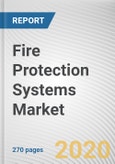Fire protection is a field wherein precautions are taken to minimize the possibility of fire that may result in injury, death, or property damage. A fire protection system is used to alert people present in a building or the area of fire and reduce the damage caused. Fire safety measures include procedures planned during the construction of a building or implemented in structures and taught to occupants of the building.
The factors such as surge in awareness regarding safety from fire and rise in residential & nonresidential construction activates drive the growth of the market. In addition, an increase in government investments in the building infrastructure sector is fueling the demand for fire protection systems. However, fluctuating raw material prices is expected to hamper the market growth. Furthermore, the technological advancements to ensure safety & security is anticipated to offer lucrative growth opportunities for the market players during the forecast period. The global fire protection systems market is classified into product type, type, end user, and region. On the basis of product type, the market is categorized into fire detection, fire response, fire suppression, and fire analysis.
Depending on type, the market is segmented into active fire protection systems and passive fire protection systems. By end user, the market is bifurcated into commercial, industrial, governmental, institutional, and others.
Region wise, the market is analyzed across North America, Europe, Asia-Pacific, and LAMEA. North America is expected to dominate the global market during the analysis period due to growth in technical advancement in fire protection systems and increase in infrastructure investments.
Competition analysis
The key companies profiled in the report include Gentex Corporation, Halma Plc., Hochiki Corporation, Honeywell International Inc., Johnson Controls International Plc., Minimax Viking GmbH, Robert Bosch GmbH, Securiton AG, Siemens AG, and Raytheon Technologies.
Key Benefits for Stakeholders
- The report provides an extensive analysis of the current and emerging fire protection systems market trends and dynamics.
- In-depth market analysis is conducted by constructing market estimations for the key market segments between 2019 and 2027.
- Extensive analysis of the fire protection systems market is conducted by following key product positioning and monitoring of the top competitors within the market framework.
- A comprehensive analysis of all the regions is provided to determine the prevailing opportunities.
- The global fire protection systems market forecast analysis from 2020 to 2027 is included in the report.
- The key market players within fire protection systems market are profiled in this report and their strategies are analyzed thoroughly, which help understand the competitive outlook of the fire protection systems industry.
GLOBAL FIRE PROTECTION SYSTEMS MARKET SEGMENTS
By PRODUCT TYPE
- Fire Detection
- Fire Response
- Fire Suppression
- Fire Analysis
By Type
- Active Fire Protection Systems
- Passive Fire Protection Systems
By End User
- Commercial
- Industrial
- Governmental
- Institutional
- Others
By Region
- North America
- U.S.
- Canada
- Mexico
- Europe
- Germany
- UK
- France
- Italy
- Rest of Europe
- Asia-Pacific
- China
- India
- Japan
- South Korea
- Rest of Asia-Pacific
- LAMEA
- Latin America
- Middle East
- Africa
Key Players
- Gentex Corporation
- Halma Plc.
- Hochiki Corporation
- Honeywell International Inc.
- Johnson Controls International Plc.
- Minimax Viking GmbH
- Robert Bosch GmbH
- Securiton AG
- Siemens AG
- Raytheon Technologies
Table of Contents
Methodology
The analyst offers exhaustive research and analysis based on a wide variety of factual inputs, which largely include interviews with industry participants, reliable statistics, and regional intelligence. The in-house industry experts play an instrumental role in designing analytic tools and models, tailored to the requirements of a particular industry segment. The primary research efforts include reaching out participants through mail, tele-conversations, referrals, professional networks, and face-to-face interactions.
They are also in professional corporate relations with various companies that allow them greater flexibility for reaching out to industry participants and commentators for interviews and discussions.
They also refer to a broad array of industry sources for their secondary research, which typically include; however, not limited to:
- Company SEC filings, annual reports, company websites, broker & financial reports, and investor presentations for competitive scenario and shape of the industry
- Scientific and technical writings for product information and related preemptions
- Regional government and statistical databases for macro analysis
- Authentic news articles and other related releases for market evaluation
- Internal and external proprietary databases, key market indicators, and relevant press releases for market estimates and forecast
Furthermore, the accuracy of the data will be analyzed and validated by conducting additional primaries with various industry experts and KOLs. They also provide robust post-sales support to clients.

LOADING...









